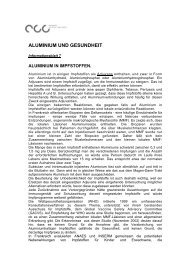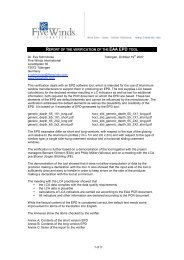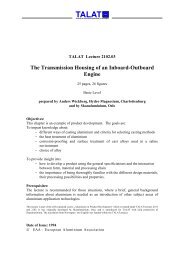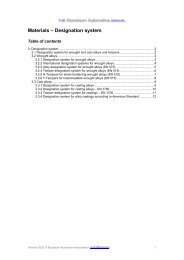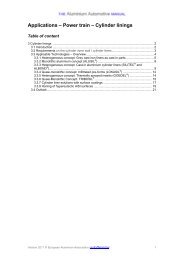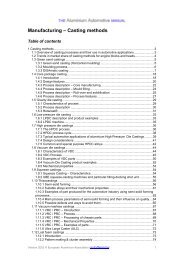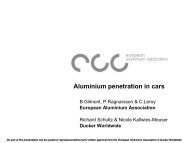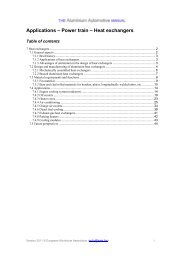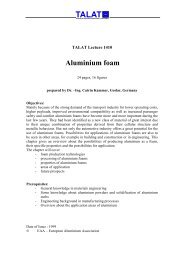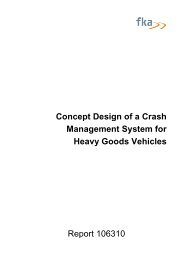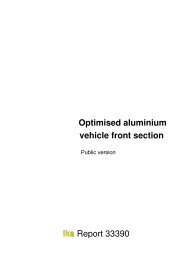aluminium in commercial vehicles - European Aluminium Association
aluminium in commercial vehicles - European Aluminium Association
aluminium in commercial vehicles - European Aluminium Association
Create successful ePaper yourself
Turn your PDF publications into a flip-book with our unique Google optimized e-Paper software.
104 EUROPEAN ALUMINIUM ASSOCIATION ALUMINIUM IN COMMERCIAL VEHICLES CHAPTER VII<br />
5.2. Upsett<strong>in</strong>g<br />
The thread is achieved by plastic<br />
deformation of the metal us<strong>in</strong>g a<br />
tap with- a rounded polygon sec-<br />
tion that has no cutt<strong>in</strong>g wedge.<br />
The diameter of the pilot hole<br />
will depend on the desired<br />
thread depth, and must be<br />
drilled accurately. Upsett<strong>in</strong>g<br />
speeds can atta<strong>in</strong> 50 m/m<strong>in</strong>,<br />
cool<strong>in</strong>g is done with cutt<strong>in</strong>g oil.<br />
Tapp<strong>in</strong>g by upsett<strong>in</strong>g offers a<br />
number of advantages with <strong>alum<strong>in</strong>ium</strong><br />
alloys:<br />
• the tap has a long life,<br />
• it <strong>in</strong>creases the hardness of the<br />
thread, its tear<strong>in</strong>g resistance and<br />
fatigue strength,<br />
• no chips.<br />
5.3. Threaded <strong>in</strong>serts<br />
It is usual to use threaded <strong>in</strong>serts<br />
– available <strong>in</strong> diameters M2 to<br />
M68 (Figure VII.9) – when<br />
screwed <strong>alum<strong>in</strong>ium</strong> alloy assemblies<br />
are required to be frequently<br />
dismantled. The <strong>in</strong>serts are <strong>in</strong><br />
the form of a spr<strong>in</strong>g made from<br />
rolled wire or are a diamond section<br />
made of sta<strong>in</strong>less steel.<br />
Captive threads can also be used.<br />
These have one or two flights<br />
that grip the flanks of the screw<br />
thread and counteract the loosen<strong>in</strong>g<br />
effects of dynamic stresses,<br />
vibrations or thermal shock.<br />
Bor<strong>in</strong>g is done us<strong>in</strong>g a standard<br />
twist drill, but tapp<strong>in</strong>g must be<br />
done with a special tap. All chips<br />
and cutt<strong>in</strong>g fluid must be<br />
removed from the bore before<br />
the <strong>in</strong>sert is fitted.<br />
Threaded <strong>in</strong>serts are fitted with<br />
pneumatic hand tools which<br />
hold them by a driver at the top<br />
end of the thread. This can then<br />
be broken off after fitt<strong>in</strong>g.<br />
Threaded <strong>in</strong>serts can also be<br />
used to repair a tap <strong>in</strong> <strong>alum<strong>in</strong>ium</strong><br />
that is worn or has been rejected<br />
dur<strong>in</strong>g manufacture.<br />
6. Deep draw<strong>in</strong>g<br />
Deep draw<strong>in</strong>g is ma<strong>in</strong>ly used <strong>in</strong><br />
the automotive sector.<br />
For more <strong>in</strong>formation on that<br />
technique, please refer to the<br />
Alum<strong>in</strong>ium Automotive Manual:<br />
http://www.eaa.net/aam/<br />
FIGURE VII.9<br />
HELI-COIL INSERTED THREAD<br />
‰<br />
‰<br />
Notch<br />
Driver



